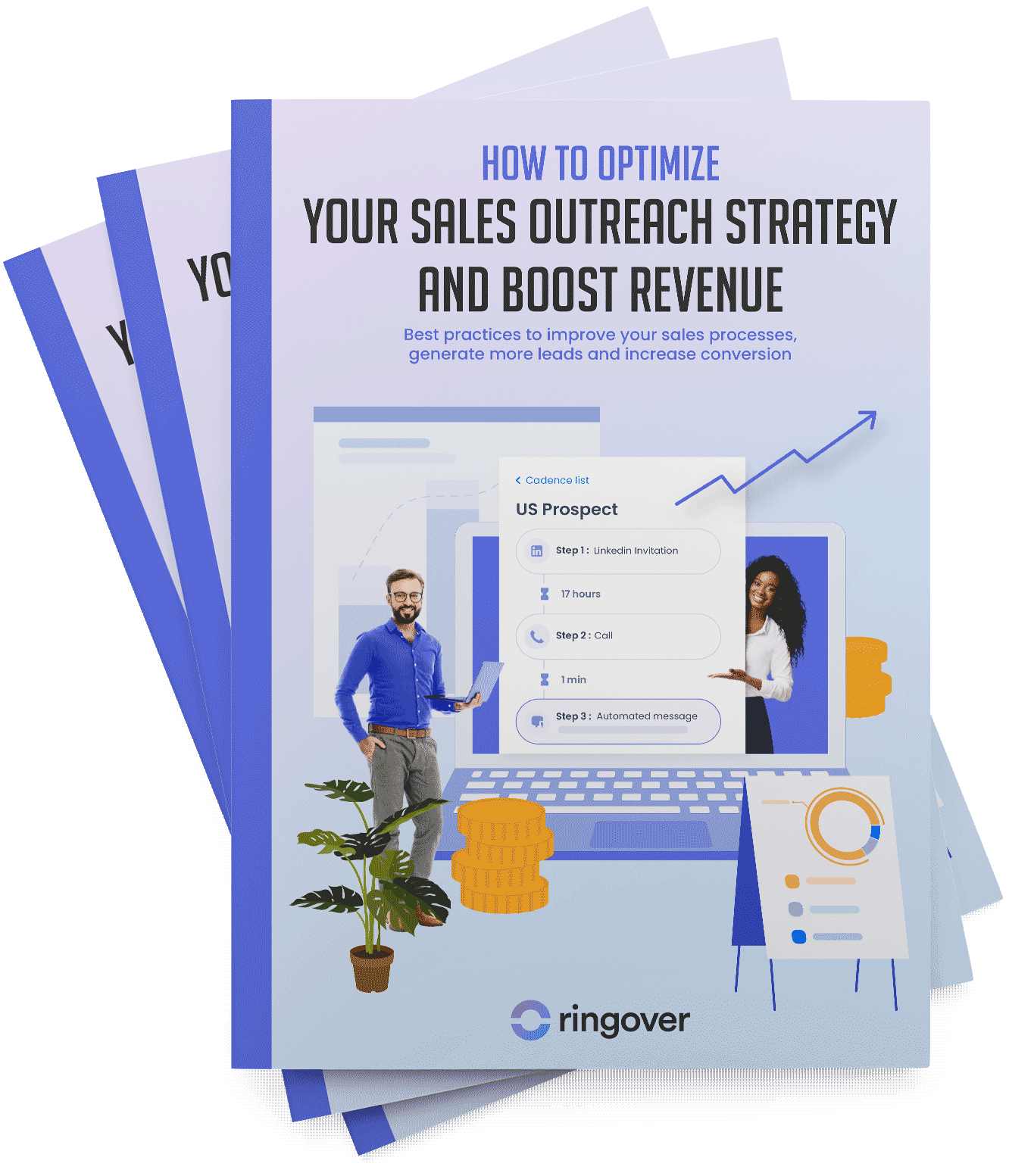Summary
You will surely agree with the following words: in the insurance sector, prospecting is neither a simple commercial reflex nor a repetitive automatism. It is a decisive lever.
Yet, it is sometimes underestimated, even though it shapes the future of agencies as well as that of large companies. General agents, independent brokers, or established groups: all must, sooner or later, face this unavoidable reality—seeking, qualifying, and convincing.
We are not talking here about simply updating a contact sheet, but about implementing a real approach consisting of discerning, in an often opaque mass of data, the individuals or companies that could truly benefit from suitable coverage.
The prospect is not a line in a CRM: he is a potential conversation, a problem to solve, a point of entry into a relationship that, if well built, can last for years.
What are, in 2025, the best strategies for effective insurance prospecting? How to achieve this when clients are over-solicited? What tools should be relied upon?
Prospecting in insurance: What strategy should be deployed?
In a sector as regulated as insurance, where every interaction takes place within a framework that is both standardized and demanding, refining your prospecting strategy becomes less a choice than a necessity. Developing a client portfolio is not a matter of luck—it is built, shaped, sometimes against the tide, often in the details. Be careful, however, not to forget that the devil is very often hidden there.
Identify your most loyal and most profitable clients
Before diving headfirst into the search for new leads, it is important to step back and observe who, today, really brings value to your business. These are sometimes the clients who rarely call but renew every year without hesitation. Others, on the contrary, have evolved with you, gradually expanding their coverage needs.
Spotting these loyal, profitable, sometimes discreet profiles is both taking stock and outlining the type of profile towards which to direct your efforts. This analysis is not limited to raw data such as premium amounts or claims frequency. It must include so-called weak signals: perceived satisfaction or even responsiveness in exchanges. So many clues that say a lot about the relational potential of a client.
By relying on these observations, you can go beyond standardized, sometimes too generic strategies. Targeted attention, refined offers, even tailor-made customer loyalty in insurance programs can turn mere satisfaction into lasting attachment.
Which market segments should be targeted today... and kept an eye on for tomorrow?
For effective insurance prospecting, precision work is often required. It is important to define specific segments according to quantitative and qualitative criteria, to avoid diluting your efforts.
Refine your targeting using solid, tangible, but also more subtle criteria: company size, sector of activity, risk profile, or even maturity level regarding insurance issues. So many benchmarks that allow you to orient your messages and offers with greater relevance.
Let's take a concrete example. SMEs, often less well covered than large accounts, represent an interesting reservoir. Their need for asset protection, liability coverage, or support in facing operational risks is real—sometimes urgent. And many are looking for partners who understand the reality on the ground, not overly generic solutions.
At the other end of the spectrum, sectors like tech, connected health, or renewable energies require very different approaches. These players—sometimes young, often growing rapidly—expect more flexible products, clauses that adapt to innovation, and messaging that keeps up with their pace.
By anticipating market trends and the evolution of client needs, you can also identify new segments to explore in the future.
How to refine customer knowledge and better respond to prospects' needs?
Refining customer knowledge is essential to succeed in insurance prospecting. This means understanding at a deep enough level what transforms a potential client into a convinced one.
In the field of insurance, where needs are sometimes latent or poorly expressed, this understanding takes on a very particular dimension.
It is not just about knowing who your contacts are, but how they think about risk coverage, when they make decisions, and why some hesitations persist despite well-crafted offers. CRM tools can play a useful role here, provided that you don't delegate all the relationship intelligence to them.
Their strength lies in their ability to group, structure, and segment. But it's in the interpretation, in the nuances, that everything plays out. A well-targeted email campaign can initiate a dialogue, but only a real, direct conversation with active listening can get to the heart of a prospect's concerns.
The richness of a phone call or meeting, even a brief one, is often underestimated. That's where unspoken objections emerge, unmet needs, and implicit expectations. These details—sometimes seemingly anecdotal—make it possible to adjust a proposal as close as possible to the client's reality.
Conversational AI allows you to more easily detect implicit signals and to explore new approaches within your interactions with prospects.
Positioning and differentiation: setting the right milestones
Once the boundaries of your market are well defined, another question arises—more demanding than it seems: how to anchor your offer in the prospect's mind in a clear, credible, and above all, distinctive way?
Positioning is not just a matter of words; it's a foundational line that structures how you are perceived.
It's not enough to claim that you do things “better” or “differently.” It still has to resonate with the concrete expectations of your target. If your customer segment mainly seeks flexibility in coverage conditions, that is where your message must take root. If others prioritize human support, that's the lever you will need to activate.
Perceived value does not rely solely on what you offer, but on how you express it—and above all, on what your competitors fail to say or do. Highlighting sharp sectoral expertise, proven service quality, or even clear, modest commitments can make all the difference.
Omnichannel: not multiplying contact points, but harmonizing them
When it comes to insurance prospecting, omnichannel software is often mentioned as a given. Yet many confuse omnipresence with coherence. The real strength of an omnichannel communications strategy is not being everywhere at once, but offering a seamless, fluid, and aligned journey.
A business phone system, email, social networks, website: each channel has its own timing, its own tone.
The challenge is not to do everything at once, but to coordinate them strategically. In fact, some prospects may prefer a single well-written message on LinkedIn over an AI cold call.
Tools like Ringover's add-on, integrated directly into the phone system, precisely allow for the unification of these interactions—to monitor and enrich them. We're no longer talking about simple channel management, but about relationship intelligence.
Well-orchestrated communication doesn't leave the moment, the medium, or the tone to chance.
Is traditional prospecting still relevant?
Should telephony still be included in your prospecting strategy?
At a time when almost everything seems to be digitizable, one question remains: does telephony still deserve its place in a well-thought-out prospecting strategy? The answer is not a simple yes or no. It depends on the context, the targets, and above all, the way this tool is used.
Certainly, the time when a single call was enough to open the door to a quick conversion seems to be over. The saturation of prospects, rising expectations for personalization, and sometimes cultural barriers have made the exercise more complex. Nevertheless, in many cases, a direct, well-prepared exchange can create a closeness no email can match.
It's not about reviving methods worn to the bone, but about giving them meaning again. A call is never just a channel—it's a moment of attention, provided it is well-targeted and part of a broader approach.
Solutions like those offered by Ringover precisely allow for structuring these exchanges, embedding them into a global logic, while keeping a useful trace for future actions.
Where telephony truly regains its meaning is when it no longer acts alone. When it integrates into an omnichannel strategy, connected with the rest of your setup, it becomes a living, personalized, potentially decisive touchpoint. But one still needs to break free from impersonal scripts and show genuine listening. It's in conversation, more than in recitation, that trust is born.
Some ideas to improve your phone scripts in insurance
An effective script in insurance prospecting relies on three pillars:
1️⃣ Immediate anchoring in the prospect's reality.
Forget empty phrases like “I'm reaching out to you in order to…”
Instead, go for a contextualized hook that shows right away that you're not calling at random:
“ I'm calling following your request for information about multi-risk coverage for your professional premises. “
or
“ I took the liberty of reaching back out to you after our conversation last June—you mentioned your needs would evolve at the start of the school year. “
2️⃣ A sincere exploration phase, without rushing the offer.
Too many scripts move quickly to selling, at the expense of listening. Ask open-ended questions, rephrase, take mental (or actual) notes:
“ What aspects of your current coverage seem least clear to you today? “
Another option:
“ Have you recently experienced any changes in your business that could impact your insurance needs? “
3️⃣ A tailored proposal, never recited.
Only after understanding do you propose — and always gradually. Rather than revealing everything at once, it's better to guide gently, offer a hypothesis:
“ At this stage, I can suggest two types of support, depending on whether you're looking for more flexibility or a more secure framework… “
How to leverage recommendations from satisfied clients?
There is a prospecting lever that is often mentioned on the sidelines, as if it belonged to another, less controllable domain: recommendations. Yet, in reality, it produces results that many paid campaigns cannot match — provided, of course, that you know how to cultivate it.
Satisfied clients are not just potential ambassadors — they are also, very often, the most credible guarantors of the promise you carry.
A well-phrased review, an authentic feedback experience, or a spontaneous referral carries significant weight in the decision-making balance of a still-hesitant prospect.
That said, the impact of a recommendation cannot be decreed. It must be prepared — sometimes in advance, sometimes through small gestures after collaboration. Inviting your clients to speak, giving them a voice in your marketing content, or highlighting their loyalty through incentive programs are all ways to keep this lever alive over time.
Again, this is not about over-automating. Word-of-mouth works when it is rooted in a real, fluid, credible relationship. At a time when trust is built slowly but lost in one click, the testimony of a satisfied client remains one of the strongest signals you can send.
Which partnerships and solutions should you prioritize to effectively fuel your insurance pipeline?
Surrounding yourself with the right partners has now become an almost organic condition for growth.
High-value-added partnerships
To generate sufficiently qualified leads — those that align with a long-term logic, not those that disappear at the first contact — collaboration with other players becomes a lever to be considered methodically.
Partnerships are not just cross-visibility agreements or good-intentioned file exchanges. They must be thought of as natural extensions of your value proposition.
Forming a link with a specialized consulting firm, a well-established local independent broker, or a player adjacent to your core business allows you to enrich your commercial approach while multiplying entry points to new targets.
Betting on the right tools and structured networking
On the tools side, things are evolving quickly. To identify and track high-potential contacts, it is now essential to rely on technologies designed for smart prospecting: dynamic CRM platforms, real estate analysis tools, or scoring solutions based on behavioral data.
But one must know how to use them — and especially how to integrate them into a global strategy rather than using them in silos.
Finally, it would be a mistake to underestimate the power of structured networking. Joining professional circles, business clubs, or industry associations is not just a social ritual. These are places where future decisions are made — quietly but surely. Trust is rarely built through a contact form; it is often forged through informal exchanges, sometimes even at events that appear to be anything but commercial.
The key, in the end, is to build an ecosystem in which your leads do not come to you by chance, but because they've seen you operate in a credible, coherent, and solution-oriented environment. This is even more true when your prospects are professionals well-versed in the process.
Integrating digital into your prospecting strategy
Today, it's difficult to envision effective prospecting without a solid digital foundation. Digital is no longer just a support channel. It is now the foundation on which other levers — including the more traditional ones mentioned earlier — are built.
Getting the most out of email marketing
Email has not lost its relevance — provided it's not used as a simple broadcasting tool. It becomes a powerful lever as soon as it is based on a deep understanding of the prospect's expectations and rigorous segmentation.
Modern emailing platforms allow for large-scale personalization: varying content based on interests, adjusting tone according to client type, scheduling sends according to key moments in the relationship. But you also need to be able to analyze the results: open rates, click-through rates, conversion rates, etc. These indicators are sometimes brutal reflections of the relevance of the messages sent.
Special attention must be paid to post-interaction sequences: a well-crafted email after a visit to your site, an abandoned quote, or an initial contact can rekindle interest at the right moment. These often-overlooked messages help build continuity in the relationship and keep the conversation open. Client relationships are not built in a single email.
Your website remains a cornerstone for lead generation
As mentioned in a previous article dedicated to lead generation in insurance: the website is far more than a showcase. It must be designed as a full-fledged conversion tool. That means going beyond aesthetics or corporate messaging — the goal is to guide the visitor, capture their attention, and turn it into action.
Everything starts with visibility. Without minimal SEO effort, even the best website will remain invisible. Producing high-value content — articles, glossaries, downloadable resources — not only answers user queries but also collects qualified leads through carefully placed forms. Again, it's an exchange logic: if you give, you receive.
It would be a shame to invest in relevant content without thinking about conversion. Each page must play a specific role, each form must be visible without being intrusive. And above all: the experience must be smooth. A slow, disorganized, or mobile-unfriendly website silently repels visitors.
Some tools — like geolocation or online appointment booking — can enrich the user experience while helping qualify prospects. But optimization doesn't stop there. Analyzing visitor behavior through fine-tuned analytics allows you to adjust the journey, identify friction points, and ultimately, continuously improve your sales performance.
What tools and technologies can boost your insurance prospecting?
Digitalizing prospecting means orchestrating a functional ecosystem, able to adapt to field realities and a constantly evolving market. In the , certain solutions clearly stand out for their ability to structure, automate, and personalize commercial efforts.
CRMs designed for your business challenges
Some CRMs don't just centralize contacts — they truly support teams in the detailed management of the sales cycle. That's particularly true of tools like OggoData, which is remarkably effective.
Designed more for brokers, this type of tool prioritizes concrete action: portfolio analysis, targeted campaign generation, contract and commercial activity tracking, seamless VoIP telephony integration… Every interaction has its place, and every prospect stays visible in the pipeline.
Other more general platforms like HubSpot or Salesforce stand out for their analytical power and ability to create complex scenarios — particularly useful when working across several verticals in parallel. These tools also make it possible to precisely measure performance — and that's the sine qua non condition for adjusting your campaigns on the fly.
Artificial intelligence, the new ear of the salesperson
Alongside CRMs, a new generation of conversational assistants is easing repetitive tasks. This refers to AI chatbots, like the one from Ringover, which simulates human conversations in writing to qualify prospects without any intervention on your part. These tools are capable of adapting to the responses received, rephrasing, and guiding.
Far from being mere gadgets, these assistants help free up time for higher value-added phases like negotiation or consulting. They also play a significant role in commercial responsiveness: being available at all hours to initiate a first contact — even outside traditional business hours — can make the difference.
As a complement, conversational analysis platforms like Empower by Ringover offer features such as automatic topic detection, identification of areas for improvement, sentiment analysis, etc.
Such a tool allows you to access precise information about the quality of calls and how to fine-tune your pitch — and even detect buying signals before competitors.
Integration is the key to avoiding inefficiencies
In this article, tools, features, channels, etc., have often been mentioned. This can quickly become complex, especially in terms of how you manage your business processes. It is precisely in this area that integration truly makes sense.
Some platforms, like CRMs for insurance, have understood this well. The best ones integrate with VoIP phone, electronic signature tools, and even direct debit management systems.
This approach streamlines workflow, ensures consistency in information, and reduces the time spent on data entry.
Key takeaways on insurance prospection in 2025
Prospecting in insurance is a demanding activity that requires a strategic and well-thought-out approach. To succeed, it's important to implement a prospecting strategy that combines traditional and digital techniques.
Far from being just a commercial component, it reflects a long-term vision capable of sustainably fueling the growth of an agency, a brokerage firm, or a group. It relies on a deep understanding of one's targets, a coherent coordination of channels, a clear positioning, and above all, an ability to create value even before a contract is signed.
Tools evolve, expectations too, but one thing doesn't change: it's quality interactions, well-placed attentions, and sincere efforts that turn a prospect into a loyal client.
So, in a constantly shifting market, one question remains: Are you ready to adopt the right tools and strategies to improve your way of prospecting and support your business growth? Sign up for a free trial today to discover how Ringover can improve performance.
Insurance Prospecting FAQ
What is insurance prospecting?
Insurance prospecting refers to the process of searching for and identifying potential clients who may benefit from insurance services. This activity involves targeting businesses or individuals with specific needs in terms of protection and risk management, in order to offer them suitable solutions.
The goal of insurance prospecting is to build long-term relationships and generate new business opportunities for the insurance company.
How to find insurance clients?
Finding insurance clients requires a strategic and targeted approach. Here are some effective methods to identify prospects:
- Use of social networks and networking platforms: Professional networks like LinkedIn allow you to identify and reach out to potential prospects (for B2B).
- Participation in trade shows and professional events: Trade fairs, conferences, and business expos offer the opportunity to meet decision-makers and interested companies (for B2B).
- Phone calls and emails: Telephoning and targeted emails are powerful tools to directly contact prospects and present your services.
- Partnerships and collaborations: Partnering with other companies or industry professionals can provide access to new audiences and benefit from their network and expertise.
What are prospecting techniques?
Insurance prospecting techniques are varied and must be adapted to the needs and preferences of prospects. Here are some common techniques:
- Cold calling: Contacting prospects by phone to present your services and answer their questions.
- Email prospecting: Targeted email campaigns allow you to personalize your messages and track interactions with prospects.
- Use of CRM systems: Customer Relationship Management systems (CRMs) facilitate the organization and tracking of interactions, making prospecting more effective and personalized.
- Networking and events: Attending professional events and maintaining a contact network fosters relationship-building and the identification of new opportunities.
- Creating valuable content: Writing blog articles, guides, or market studies helps attract and engage prospects, while positioning you as a reliable and expert source.
Published on May 13, 2025.




